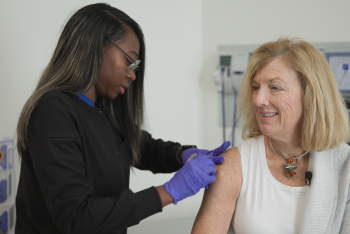Hand, foot and mouth disease (HFMD) is a common viral illness that primarily affects young children...
Read MoreEffective Monday, January 5th, Inspira Health is now at Yellow Alert Status: Masks for staff, patients and visitors in all high-risk areas across our facilities are strongly recommended.


Currently, one in five U.S. citizens has a sexually transmitted infection (STI). Of the 26 million newly diagnosed STIs in 2018, nearly half were diagnosed in individuals between 15 and 24 years of age. The rate of STIs continues to rise, and with it, so does the need for increased access to and information about STI testing, treatment and prevention. To help simplify an often overwhelming—and sometimes painful—process, here are your STI basics.
A sexually transmitted infection is any infection transmitted through oral, vaginal or anal sex9ual activity. “STIs can also be transferred through non-sexual acts like sharing needles and even breastfeeding,” said Jennifer Naticchia, M.D., primary care physician at Inspira Medical Group Primary Care Somerdale. “Currently, there are at least 20 known STIs—some of which can be easily treated and others that are much more serious.”
The most common STIs include:
Catching and treating STIs early requires vigilant preventive monitoring, as well as immediate action when you notice something doesn’t seem right. STIs exist on a large spectrum, including both bacterial and viral infections. That means not only will each STI present differently but they will also require different treatments.
“While infections such as chlamydia, gonorrhea, syphilis and trichomoniasis can be treated and cured, other viral infections cannot be cured—such as hepatitis B, herpes, HIV and HPV,” said Dr. Naticchia. “STIs can be spread unknowingly, which is why having regular testing, in addition to practicing safe sex, is critical. The frequency of your STI testing depends on your number of partners, how you engage in sexual activity and your previous STI history.”
In general, it’s a good idea to check in with your doctor once per year, or whenever you have a new sexual partner, about STI testing. You may have an STI without symptoms, so regular preventive testing is a good idea, even if you don’t experience signs of an infection.
The current, general guidelines are:
The best way to prevent contracting an STI is by engaging in safe sex. That means always using protection, like male and female condoms and dental dams.
“If you have an unprotected sexual encounter, you need to always consider the health of yourself and your future partners,” said Dr. Naticchia. “That means make sure you are communicating with your primary care provider regularly, speaking openly and honestly about your sexual history and completing the recommended tests. Catching STIs early does more than help treat and cure them quickly, it prevents them from turning into chronic, lifelong illnesses.”
Not sure how to talk about your sexual health? Try asking your primary care provider about:

Hand, foot and mouth disease (HFMD) is a common viral illness that primarily affects young children...
Read More
Lice infestations tend to increase during the cooler months as kids share hats, coats and other gear...
Read More
Inspira Health CEO Amy Mansue tours Primary Care office, chats with Dr. Kristen Trom about annual...
Read More